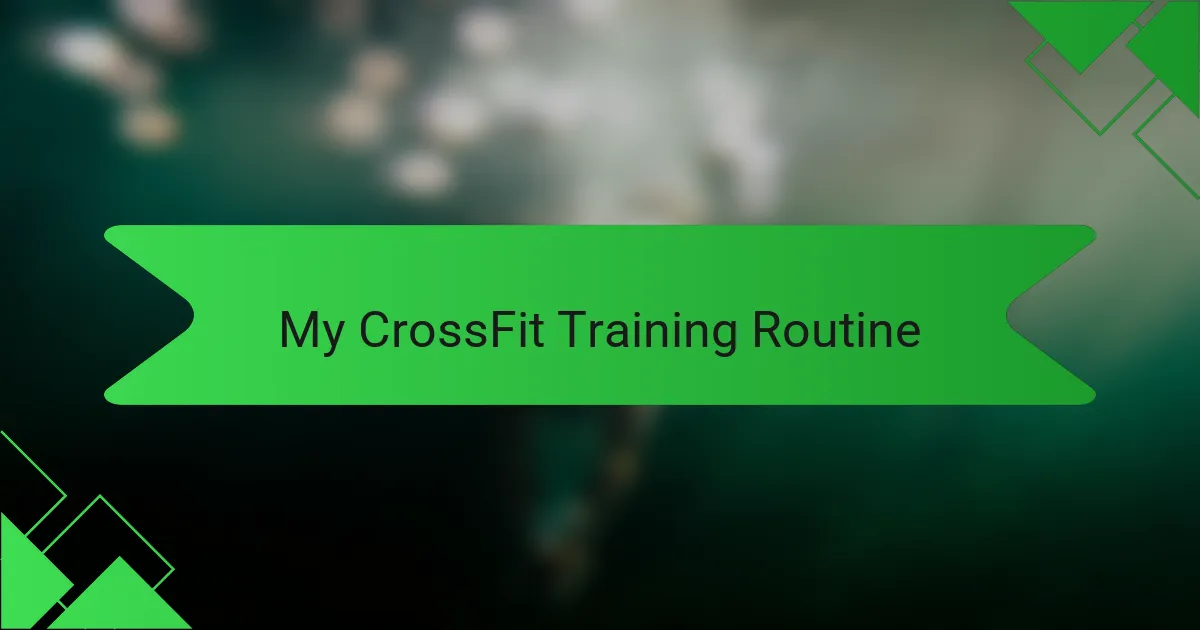Key takeaways
- Obstacle Course Racing (OCR) combines running with physical challenges, requiring strength, agility, and mental toughness.
- CrossFit significantly enhances functional strength, endurance, and mental resilience, essential for tackling OCR obstacles.
- A diverse workout routine, including exercises like deadlifts and box jumps, improves grip strength and stamina for OCR performance.
- Balancing CrossFit with specific OCR training is crucial for skill development and injury prevention during races.

What is Obstacle Course Racing
Obstacle Course Racing (OCR) is a thrilling sport that combines running with various physical challenges or obstacles. From my first race, I realized it’s not just about speed but also strength, agility, and mental grit. Facing muddy walls and rope climbs tested me more than any regular run ever did.
| Obstacle Course Racing (OCR) | Traditional Running |
|---|---|
| Includes obstacles like walls, ropes, and mud pits | Focuses on continuous running with no obstacles |
| Demands a mix of strength, endurance, and coordination | Primarily emphasizes cardiovascular endurance and pace |
| Mental toughness is key to overcome unexpected challenges | Mental focus centers mostly on pacing and endurance |

Benefits of CrossFit for OCR
One of the biggest benefits I found in CrossFit for OCR was how it built functional strength. Rather than just lifting weights to get bigger, CrossFit challenged me with varied movements that mimicked obstacles—think rope climbs, carries, and box jumps. This made each race obstacle feel less intimidating because I had practiced similar motions repeatedly.
Endurance and mental toughness also got a serious boost from CrossFit. On days when the WODs (workouts of the day) pushed me to my limits, I realized I was preparing for more than just physical fatigue—I was training my mind to stay focused when everything hurt. Have you ever felt that sharp edge of exhaustion but kept pushing forward? CrossFit taught me how to embrace that discomfort and use it as fuel.
Lastly, the community aspect of CrossFit added a surprising benefit to my OCR journey. Being surrounded by people who celebrated every small victory gave me a mental edge during races. When you know you’ve pushed through brutal workouts with others cheering you on, tapping into that energy during an OCR event becomes a powerful reminder that you’re never truly alone out there.

Key CrossFit Workouts for OCR Training
CrossFit workouts have been a game-changer in preparing me for obstacle course racing, especially because they combine strength, endurance, and functional movements. When I first incorporated specific CrossFit exercises into my routine, I noticed a marked improvement in my grip strength and overall stamina — two critical elements when facing tough obstacles.
Among the key workouts, these stood out in boosting my performance and confidence during OCR events:
- Deadlifts: Built raw strength for lifting and carrying heavy objects on the course.
- Pull-Ups: Essential for climbing walls and monkey bars.
- Box Jumps: Improved explosive power and agility to clear obstacles quickly.
- Farmers Carry: Enhanced grip and core stability, which helped with endurance sections.
- Burpees: Increased cardiovascular endurance and mental toughness, especially during grueling races.
- Kettlebell Swings: Developed hip drive and overall conditioning, making transitions between obstacles smoother.
Each workout targeted a specific challenge I faced in OCR, and combining them in CrossFit-style circuits kept my training dynamic and engaging.

My CrossFit Training Routine
When I first started integrating CrossFit into my obstacle course racing (OCR) training, I was surprised by how quickly my overall fitness improved. The varied, high-intensity workouts kept me engaged and pushed me beyond my limits, which made a noticeable difference on race day. I especially appreciated how CrossFit targeted the diverse skills needed for OCR, from grip strength to explosive power.
Over time, my routine evolved to balance skill work and conditioning. I realized that consistency was key, and tailoring workouts specifically to OCR demands helped me feel more confident tackling obstacles. Here’s a snapshot of a typical week that worked well for me:
- Monday: Olympic lifting (clean and jerk, snatch) to build explosive power
- Tuesday: Metabolic conditioning (WOD – Workout of the Day) focusing on burpees, box jumps, and rowing
- Wednesday: Gymnastics skills (ring dips, pull-ups, handstand holds) to improve upper body strength and coordination
- Thursday: Mixed modal workout with kettlebell swings, sled pushes, and running intervals
- Friday: Endurance day – long runs or rucking with weighted vest to simulate race conditions
- Saturday: Active recovery or mobility work, emphasizing foam rolling and stretching
- Sunday: Rest day to let the body recover and adapt
This routine gave me a real sense of progress and kept me energized for both training and racing.

How CrossFit Improved My OCR Performance
CrossFit sharpened my ability to tackle obstacles that once felt daunting. I remember during a race when a tall wall seemed impossible, but thanks to repeated box jumps and pull-ups from my CrossFit sessions, I scaled it without second guessing. That confidence in my body’s capacity changed everything.
Have you ever hit a point mid-race where your muscles scream and your mind wants to quit? CrossFit taught me to lean into that discomfort rather than avoid it. The intense WODs prepared me to keep pushing even when exhaustion was overwhelming, and in those moments, I found strength I didn’t know I had.
Another thing that stood out was how CrossFit improved my grip and core strength, which made rope climbs and carries feel smoother and less exhausting. It wasn’t just about getting stronger—it was about being smarter with my energy during races. That practical fitness edge truly made me a better OCR athlete.

Challenges Encountered Using CrossFit for OCR
Challenges popped up quickly when I started using CrossFit to train for OCR. While the high-intensity workouts built my strength and endurance, I sometimes felt they didn’t fully match the specific skills I needed for obstacles like crawling or carrying uneven loads. There were moments I struggled with the transition from a controlled gym environment to the unpredictable nature of an OCR course.
| Challenge | Experience |
|---|---|
| Specificity of Training | CrossFit emphasized general strength, but I found it lacked focus on OCR-specific movements like crawling under barriers. |
| Injury Risk | The intense, high-impact nature of CrossFit occasionally led to minor injuries, making me cautious about pushing too hard before a race. |
| Adaptability | CrossFit workouts are structured and timed, but OCR requires adapting to varied terrain and obstacles, which I had to practice separately. |

Tips for Combining CrossFit with OCR Training
CrossFit and OCR training complement each other well, but finding the right balance is crucial. From my experience, prioritizing recovery days helped me avoid burnout while still progressing in both areas. I learned to emphasize functional movements in CrossFit that directly translate to OCR challenges, which made my race days feel more manageable and rewarding.
| Aspect | CrossFit | OCR Training |
|---|---|---|
| Primary Focus | High-intensity strength and conditioning | Endurance, grip strength, and obstacle technique |
| Training Style | Structured workouts with varied movements | Combination of running, climbing, and crawling |
| Recovery Needs | Essential due to high intensity | Important for endurance and injury prevention |
| Benefits to OCR | Builds explosive power and muscular endurance | Improves obstacle-specific skills and stamina |
| My Experience | Enhanced overall strength but required careful scheduling | Helped me refine technique and race strategy |
